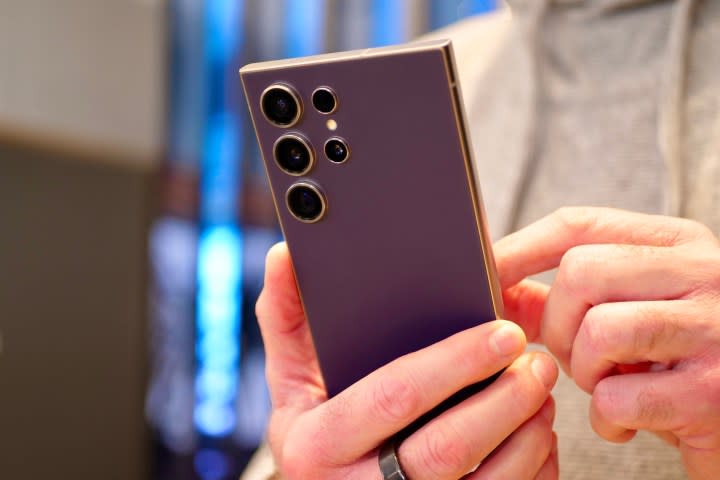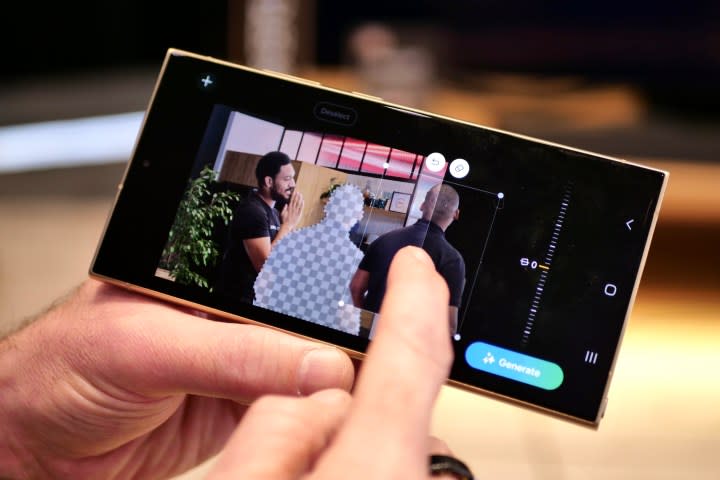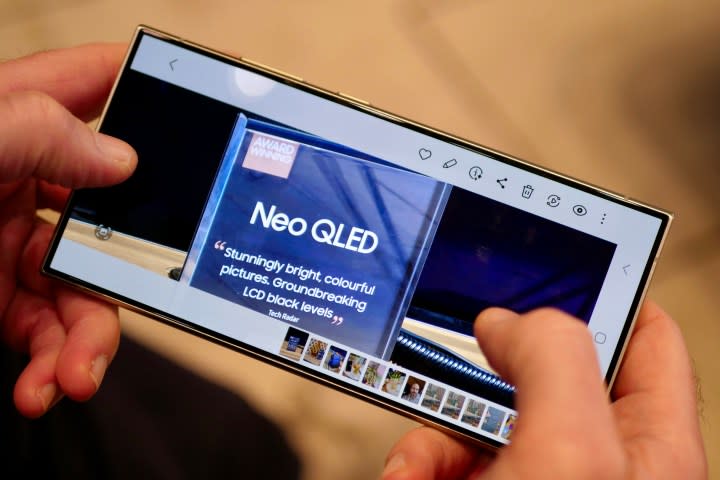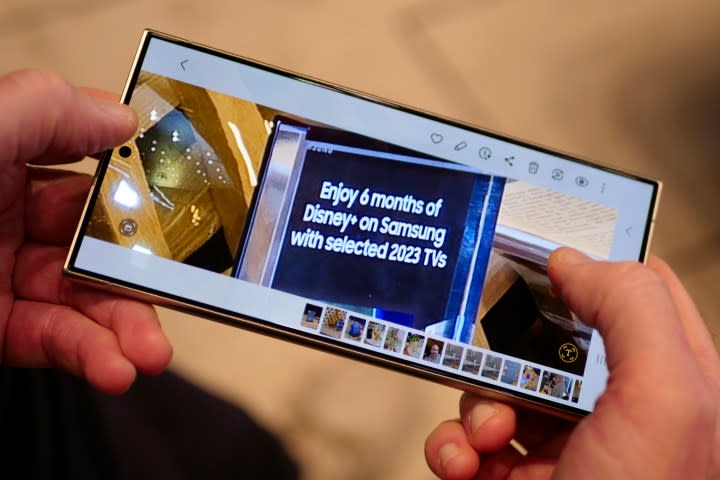The Samsung Galaxy S24 Ultra turned me into an AI believer
This article contains affiliate links; if you click such a link and make a purchase, Digital Trends and Yahoo Inc. may earn a commission.
I’m sick of hearing about AI and all that it could do for us in the future, both good and bad. That’s why my heart sank when it became clear that Samsung would push AI heavily on the new Galaxy S24 Ultra. The powerhouse smartphone series already does almost everything you could want, so adding generative AI capabilities seemed like bandwagon jumping and nothing that we hadn’t seen on phones like the Google Pixel 8 and Pixel 8 Pro.
Well, that was before I gave it a try and had a few demonstrations of its ability. I’m not eating my words just yet, but I’m definitely putting the oven on and getting a plate and cutlery out, as it was far better than I expected.
Galaxy S24 Series & Galaxy AI Hands-On | Samsung Unpacked 2024
The Galaxy S24 Ultra’s shape and design
Before I go into why the AI turned out to be better than I expected, I want to talk about how the shape and feel of the S24 Ultra have changed. Most notably, the frame is now made of titanium, an upgrade over the Armor Aluminum used for the Galaxy S24 and Galaxy S24 Plus.
The shape is more palm and hand-friendly, and I barely noticed the screen is now flatter than the Galaxy S23 Ultra, something that did concern me before I picked up the phone. The slimmer bezels around it are more distinct and help emphasize the size of the 6.8-inch screen.
All this means the Galaxy S24 Ultra looks and feels suitably different from the Galaxy S23 Ultra, even if the changes seem small. It’s still a big and bulky phone — and still instantly recognizable as an Ultra model from the back, as the camera module looks identical. However, the simple, subtle alternations have managed to make the S24 Ultra its own thing.
The titanium frame has a warmth to it as it does on the iPhone 15 Pro Max, but outside of the cache attached to such a material, it doesn’t add a lot to the phone. I really like the satin-feel back panel, though, which promises to be less slippery than the Galaxy S23 Ultra.
Finally, although I only spent an hour or so with the Galaxy S24 Ultra, the screen is utterly glorious. It’s brighter than ever, has a 1-120Hz refresh rate, and a massive QHD+ resolution. It’s a treat to look at and a reason to choose the Galaxy S24 Ultra over many other expensive flagship phones.
Meaningfully applied AI
When the Galaxy S24 Ultra was introduced to me at a press event, Samsung spent a few moments talking about the evolution of the Ultra series and that it wanted to “meaningfully apply AI” to the S24 Ultra so its ability could be enjoyed by many. I was skeptical, as it wasn’t the first time I’d heard such a statement. Even the explanations of Galaxy AI’s tech and features began to make my eyes glaze over.
But the proof of the AI would be in its generatively produced pudding. The first feature I tried was called Circle to Search with Google, where you circle an item on the screen with your finger, and a page with information on the item appears below it. It can be anything from a building in a photo to a product in front of you snapped by the camera, and it even works in some social networking apps. It instantly recognized my STM Bags backpack, meaning I could have located a shop online to buy it if I wanted.
Now, this isn’t something very new, but it did work very cleanly, and activating the feature — a long press on the home button or gesture bar — was quick and simple. However, it was the new AI photo editing tools that sold me on Samsung’s ability to deliver AI features with exciting potential. The enhanced editor can remove reflections, add a portrait effect, straighten images, and — most intriguingly — move or delete figures and fill in the blanks left behind.
I snapped a few photos in the event space and gave it a try. It’s incredibly easy to get started, and all it takes is a haphazard trace around a figure for the software to understand what you want to do. It took just a few moments to delete the figure and fill in the background, to the point where I wouldn’t have known a second figure was at one point in the photo despite the scene’s complexity. It looked fantastic, and it impressed me more than the times I’ve used a similar feature on a Pixel phone.
I then watched a demo of the Live Translate feature, where a split screen view on the phone allows two people to have a “conversation,” as it translates the two languages in real time. It wasn’t perfect, but it was close enough that both parties would have known what was being said. The same feature can even be used in a call.
I couldn’t test this or any of the other translation features in detail, but judging how well the AI worked in the quick demo I had and in the photo editing mode, it appears Samsung has worked hard to make its AI features meaningful after all.
A camera downgrade?
The 10x optical zoom that made the Galaxy S23 Ultra so unique has been replaced by a 5x optical zoom and an “optical quality” 10x mode for the Galaxy S24 Ultra. Taking photos with the camera inside showed the 5x zoom is crisp, sharp, and packed with detail, but I’m not convinced by the hybrid mode for 10x. The shots looked good but lacked the blur-free sharpness seen in the 5x optical zoom photos.
Samsung’s AI is at work here, too, with its ProVisual AI engine enhancing shots at 1x, 2x, 3x, 5x, and 10x zoom. The sensors are also new, the pixels are larger, and the optical image stabilization (OIS) has been updated to provide even better lowlight photos and video. A Super HDR feature works across the entire camera, from the on-screen preview to the gallery, and even in the camera apps in Instagram and Snapchat. I didn’t get the chance to play with the new slow-motion video mode, which also uses AI to fill in the blanks as it slows video down even more.
Everything happens at lightning speed, too, with the Galaxy S24 Ultra powered by an enhanced Qualcomm Snapdragon 8 Gen 3 processor, providing a higher clock speed and GPU performance than the standard versions found in phones like the Asus ROG Phone 8 Pro.
It’s worth noting that in Europe and the U.K., the Galaxy S24 and Galaxy S24 Plus use a Samsung Exynos 2400 processor. Samsung promises seven years of software updates with the Galaxy S24 series, so these are phones with the potential to last for many years.
Be prepared to pay more this year
I didn’t need to use the Galaxy S24 Ultra for hours to know already that it will be one of 2024’s best flagship phones. Samsung nailed the formula a few years ago and continues to refine and perfect it. My initial skepticism around the Galaxy AI features seems unwarranted, but how often anyone will use them remains to be seen, and it doesn’t matter how good they are if you have no use for them in the first place. The altered camera is also a bit of an unknown at this stage.
For the most part, Samsung’s alterations and updates to the S24 Ultra are intriguing and look to be fun and useful too, but the change to the cost of the phone isn’t very welcome at all. The Galaxy S24 Ultra starts at $1,299 or 1,249 British pounds, up from the Galaxy S23 Ultra and even more expensive than the Apple iPhone 15 Pro Max and the Asus ROG Phone 8 Pro — two of its most capable competitors.
The trouble is, the S24 Ultra’s higher price also edges it closer to the Google Pixel Fold and the OnePlus Open, and they’re tempting in a different way. Much as Galaxy AI impressed, I don’t know if it will be enough for people to justify spending even more money on a non-folding phone, particularly as the camera may not be quite as versatile as the S23 Ultra’s.
The Galaxy S24 Ultra will be released on January 31, and we’ll fully review it soon. If you’re more interested in Samsung’s cheaper options, see our Galaxy S24 and S24 Plus hands-on coverage.

 Yahoo Autos
Yahoo Autos 
















